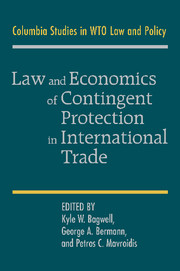Book contents
- Frontmatter
- Contents
- Contributors
- Introduction
- 1 An Overview of the Agreement on Subsidies and Countervailing Measures – Including a Discussion of the Agreement on Agriculture
- 2 Do the World Trade Organization Disciplines on Domestic Subsidies Make Sense? The Case for Legalizing Some Subsidies
- 3 Subsidies and Countervailing Measures: Determining the Benefit of Subsidies
- 4 The Enduring Problem of World Trade Organization Export Subsidies Rules
- 5 The Boeing–Airbus Dispute: A Case for the Application of the European Community State Aid Rules?
- 6 Antidumping: Overview of the Agreement
- 7 Price Differentiation in Antitrust and Trade Instruments
- 8 Nonpreferential Origin Rules in Antidumping Law and Practice
- 9 The Appellate Body Interpretation of “Sunset Reviews” Provisions of Anti-Dumping and Countervailing Measures Agreements: A Critical Analysis
- 10 The Safeguards Agreement – An Overview
- 11 Why Are Safeguards Needed in a Trade Agreement?
- Index
- References
6 - Antidumping: Overview of the Agreement
Published online by Cambridge University Press: 03 May 2010
- Frontmatter
- Contents
- Contributors
- Introduction
- 1 An Overview of the Agreement on Subsidies and Countervailing Measures – Including a Discussion of the Agreement on Agriculture
- 2 Do the World Trade Organization Disciplines on Domestic Subsidies Make Sense? The Case for Legalizing Some Subsidies
- 3 Subsidies and Countervailing Measures: Determining the Benefit of Subsidies
- 4 The Enduring Problem of World Trade Organization Export Subsidies Rules
- 5 The Boeing–Airbus Dispute: A Case for the Application of the European Community State Aid Rules?
- 6 Antidumping: Overview of the Agreement
- 7 Price Differentiation in Antitrust and Trade Instruments
- 8 Nonpreferential Origin Rules in Antidumping Law and Practice
- 9 The Appellate Body Interpretation of “Sunset Reviews” Provisions of Anti-Dumping and Countervailing Measures Agreements: A Critical Analysis
- 10 The Safeguards Agreement – An Overview
- 11 Why Are Safeguards Needed in a Trade Agreement?
- Index
- References
Summary
Background
Dumping is generally defined as the act of an exporter selling a product in an export market at a price below that which is charged for the same or comparable merchandise in the home market. Where dumping has the effect of causing injury to the domestic industry in the importing country, the General Agreement on Tariffs and Trade (GATT) and World Trade Organization (WTO) Antidumping Agreement permit antidumping measures, in the form of increased duties, to counteract or offset the dumping.
In fact, the Contracting Parties to the GATT, as well as the Members of the WTO, have recognized that injurious dumping is “to be condemned.” The reason for such strong language is that, although consumers of dumped products may benefit in the short term from lower prices, dumping sends false market signals about the underlying competitive positions of market participants. As U.S. Assistant Attorney General Samuel Graham put it in 1916:
[G]enerally accepted principles of political economy hold that it is not sound policy for any Government to permit the sale in its country by foreign citizens of material at a price below the cost of production at the place produced, for the reason that such a system, in its final analysis and on a sufficient scale, spells bankruptcy.
Hence, governments use antidumping measures to protect their domestic industries from injury caused by unfair international price discrimination.
- Type
- Chapter
- Information
- Publisher: Cambridge University PressPrint publication year: 2009
References
- 2
- Cited by



